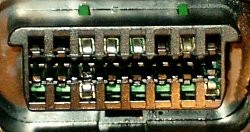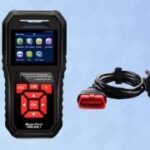Does your car have OBD2? Knowing if your vehicle is equipped with an On-Board Diagnostics II (OBD2) system is crucial for diagnostics and repairs. This guide will help you determine if your car is OBD2 compliant.
How to Tell if Your Car Has OBD2
OBD2 compliance is determined by the vehicle’s model year and the country where it was originally sold. Here’s a breakdown:
United States
All cars and light trucks sold in the United States with a model year of 1996 or newer are required to be OBD2 compliant. This includes a wide range of manufacturers such as Ford, Chevrolet, Toyota, Honda, and more. The Environmental Protection Agency (EPA) mandates this compliance.
Fig. 1 – Standard OBD2 Connector (J1962 Vehicle Connector, Type A)
European Union
- Gasoline Vehicles: Full OBD2 compliance is required for gasoline vehicles with a model year of 2001 and newer. Vehicles from 2000 may have limited compliance.
- Diesel Vehicles: Full OBD2 compliance is required for diesel vehicles with a model year of 2004 and newer. Vehicles from 2003 may have limited compliance.
Important Note: “European Union” in this context refers to countries that were EU members in 2000/2003.
Other Countries
OBD2 compliance varies significantly in other countries. The table below outlines the requirements for various regions:
| Country of Sale | Model Years | Notes |
|---|---|---|
| Canada | 1998 | |
| Japan | 2008+ | Limited Compliance 2003-2007 |
| Australia (Petrol) | 2006 | |
| Australia (Diesel) | 2007 | |
| Brazil (Petrol) | 2007+ | Limited Compliance 2005-2006 |
| Brazil (Diesel) | 2015+ | Limited Compliance 2013-2014 |
| China (Country – Petrol) | 2010 | |
| China (Country – Diesel) | 2011 | |
| India | 2017+ | Limited Compliance 2013-2016 |
| Mexico | 2007 | |
| South Korea | 2010+ | Limited Compliance 2005-2009 |
| and many more… |


Note: This is not an exhaustive list. Consult your vehicle’s owner’s manual or a trusted mechanic for specific requirements in your region.
Finding the OBD2 Port
If your car is likely to be OBD2 compliant based on the information above, look for the OBD2 port. It’s typically located under the dashboard on the driver’s side, often near the steering column or fuse box. The port is a trapezoidal, 16-pin connector.
Fig 2: Example of a Non-Standard Connector (Ford Escort DLC) Note the different shape compared to the standard OBD2 connector. Just because your car has a 16-pin connector doesn’t guarantee it’s OBD2 compliant.
What if My Car Isn’t OBD2 Compliant?
If your vehicle is not OBD2 compliant, you may still have access to diagnostic information through manufacturer-specific protocols. Consult your vehicle’s service manual or a qualified technician for more information.
Conclusion
Determining if your car has OBD2 is essential for troubleshooting and maintenance. By using this guide and checking your vehicle’s documentation, you can quickly find out if your car is OBD2 equipped. If you’re still unsure, consulting a professional mechanic is always recommended.
